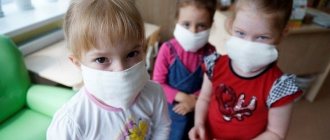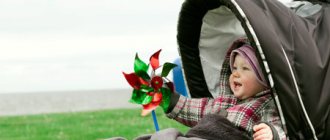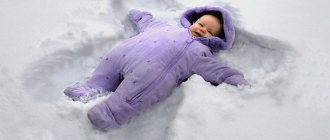Young mothers who have just returned from the maternity hospital immediately begin to face many questions, the most common of which are when can they start walking with their newborn and whether it is necessary to walk with the child every day. Parents whose children were born in winter are especially worried about this. Therefore, it will be useful for all of them to know when they can take their child’s first walk in his life and what rules to follow at different times of the year.
Newborn in a stroller sleeping
The benefits of walking for babies
Walking is simply vital for a child, both when he is already grown up and when he is still small. Reasons why you need to walk with your small child every day:
- A walk outside helps train the process of thermoregulation in the baby's body and strengthens his nervous system.
- Joint outdoor recreation is the best way to create and strengthen the emotional connection between parents and their baby.
- On the street, the child’s body takes a break from the harmful influence of “household residents,” since even in the most sterile apartment there are many pathogenic microorganisms.
- During a walk, the baby's lungs are cleared of dust accumulated in them.
- Vitamin D, essential for growth and development, is produced in the body only under direct exposure to sunlight.
- The baby will train his vision. By alternately looking at objects up close and from afar, the child will do a kind of exercise for the eyes.
- With good equipment, walks in cold weather, light rain or snow will only bring benefits to the child and many positive impressions.
- On the street, an infant will receive a huge boost in his development, and he will also go through the first stage of socialization. Birds singing, sun rays, raindrops, new faces, first friends in the sandbox - this is a new, still unknown world for the baby, which he will be so interested in getting to know.
Note! There is no need to go for a walk if the baby has a high fever, pain and weakness. During the recovery period, you need to walk 1.5-2 hours a day, as fresh air will help restore the small body.
Baby sleeping in a stroller on the street
Is it necessary to go for a walk every day?
According to the recommendations of many pediatricians, you need to walk with your baby at least twice a day: in the morning and in the evening. Newborn babies sleep very well during walks, especially if the mother pushes the stroller all the time. For this reason, the best solution would be to choose the option of combining a walk and sleep. When a newborn baby has already fully adapted to the street, in the warm season you can walk, for example, in the morning and evening for two to three hours.
Self-massage for a one-year-old child
Why should you take your baby for a walk every day? A walk in the fresh air is very important for the well-being and proper development of young children. This is an excellent preventive and hardening measure. Fresh air (cool and dry, warm and humid) is considered very useful for a small organism, since a baby breathes three times more often than an adult, and the ability to obtain oxygen from the air in newborn babies is not yet sufficiently developed. Oxygen is very important for all life processes and good development. The task of parents is to organize the process of oxygen entering the child’s body as best as possible.
Important! If the weather is good in autumn, spring or summer, pediatricians advise taking the newborn for a walk 2 or three days after discharge from the hospital. If it is winter outside, then it is better to postpone the first walk with an infant to the seventh day after discharge. At lower temperatures, you should wait for warmer weather and, instead of walking outside, take the baby out onto a glazed balcony with the window open for ventilation for 10-15 minutes.
Child on a winter walk
Why go for a walk with your child? Where and how? And is there any benefit from walking on playgrounds?
It is necessary to walk with the child from the very birth, but, unfortunately, not all parents want, understand the need and are ready to walk for a long time with the child, and then they begin to wonder why the baby gets sick more often, does not develop as quickly as peers, and so on. Active and long walks, wherever they take place: a playground, in a park, outside the city, at the sea, and so on, will only benefit a child of any age. Here are some indisputable facts that confirm the benefits of your child being outdoors, even on the most ordinary playground in the yard:
- we breathe fresh air - rest assured, the air outside is in any case cleaner than in an ordinary apartment;
- we cleanse our lungs of house dust, allergens, bacteria and other harmful particles hidden from our eyes;
- we increase energy consumption and improve the functioning of the whole body;
- we get vital vitamin D;
- we stimulate the child’s physical activity, which promotes intellectual development, strengthening the immune system and the cardiovascular system;
- coordination and reaction develop and the eyes are trained, preventing vision problems.
- we walk in any weather, thereby strengthening the child and introducing him to various natural phenomena;
- We don’t skip walks even with minor colds (without fever), so the child will cope with his illness faster;
- Observation develops, horizons expand, the child learns to navigate in space, and imagination develops.
To all the described advantages, you can add the benefits of playing on playgrounds. Here the child develops fine motor skills by playing with sand, pebbles, grass and so on, swings and carousels develop the vestibular apparatus, slides and all kinds of ladders help in physical development, here you can play ball or run catch-up, here children get to know their peers, learn to communicate, make friends, share toys, play together, splashing out their energy and receiving great benefits along with pleasure! Just remember to follow the rules for staying in the sun in order to avoid photodermatitis.
Of course, if possible, you should definitely go to new places with your child - walk in the parks, go to the forest, go swimming, introduce them to nature, in winter, do not limit yourself to four walls, but play outdoor games, teach sledding and skiing, in general , contribute in every possible way to the development of the child, his independence and self-confidence.
This is how many benefits are hidden in seemingly simple walks in the fresh air - do not infringe on your child, allow him to fully develop - just go outside with him.
What to take for a walk
How to develop a child at 4 months - educational games and activities
When packing for a long walk with your baby you will need:
- Depending on the season, a warm or thin blanket;
- Raincoat, in case of rain;
- In the warm season, an anti-mosquito net to protect the child from insects;
- Diapers, a few just in case;
- 2-3 toys;
- A pack of wet wipes;
- Bottle with drinking water;
- Pacifier (if the child is accustomed to it);
- If the baby is bottle-fed, a thermos with hot water and formula;
- If after the walk you plan to go on a visit with your baby, you need to take a change of clothes;
- For children from six months - a thermos with herbal tea.
Additional Information. If the weather is rainy outside, and the mother thinks why she should go outside, you can take a walk with the child on the balcony. A good solution would be to find a suitable pavilion with a canopy in a nearby yard. It is also very convenient to move with a stroller, covering it with a raincoat, this will help protect the baby from cold raindrops. A raincoat usually comes with the vehicle.
Things you need for a walk
Tips for walking with a baby
How much should an 11 month old baby sleep per day?
When going for a walk with your baby, you need to follow these tips:
- You should start your first walk with your newborn with 10 minutes of being outside. In the future, increase the time by another 10 minutes daily. When the baby goes through the adaptation period, you can begin to develop your own regime.
- In summer, mother and child can walk almost all day long, provided that the weather is not very hot. If the air temperature has reached above + 30° C, it is better to move the walk to the morning or evening so as not to overheat the baby.
- In spring and autumn, you can almost always walk with your baby, except during periods of heavy rain and wind. Walks can be quite long – 2-3 hours.
- When the child grows up and sleeps less, you need to teach him to go for walks while he is awake and sleep at home. Such a schedule will give mom the opportunity to relax and do all her household chores in peace.
- In winter, when the frost is from -10 to -15° C, you should not give up walking. You can walk for about 1.5-2 hours a day. Frost is an excellent disinfectant, as it destroys all pathogenic viruses and bacteria in the body.
- You should avoid walking only in winter when there is severe frost above -15° C, as well as during rain and hail. You need to be careful when walking in windy weather, since the dust that the wind raises carries with it a lot of different microbes.
- In hot weather, you need to avoid direct sunlight, which can burn your baby's delicate skin, so it is better to walk in cool, shady places.
- You need to dress your newborn according to the weather so that he does not get too cold or overheat.
- To ensure that your baby breathes only through his nose during a walk, you can give him a pacifier, pre-attached to his clothes with a ribbon or a special clothespin.
- To walk with a newborn, you need to buy a special stroller. It should be on wheels with shock absorbers, a flat bottom, and a mattress made of natural material.
- First, the mother should get ready and dress for a walk, only then should she outfit the baby, so he won’t overheat and sweat.
- For a walk, it is preferable to choose quiet places that will be located away from roads and a large number of cars. The most suitable places are a square, a park area and a children's playground.
- When going for a walk, it is better for the baby to wear clothes made of natural material so that it does not irritate his delicate skin.
- In summer it is very important to protect your baby's skin from the scorching sun. Put a cap on his head to prevent sunstroke.
- It is better to go for walks several times a day, focusing on the baby’s feeding schedule. If you go outside between feedings, this will extend the walking time, the baby will not have time to freeze, and his sleep will be sound.
- When going outside, you need to take a bottle of boiled water and a pacifier. If the baby wakes up and starts crying, he can be distracted for a short time.
Walking clothes
Also, do not forget that:
- During the walk, you need to make sure that the child is neither cold nor hot;
- For a walk, you need to dress your baby in layers, so that later you can take something off if he suddenly gets hot;
- While walking, it is better to avoid noisy places such as avenues, squares, markets, highways;
- If the weather is bad outside, there is no need to deprive your child of the opportunity to breathe fresh air. A regular walk can easily be replaced by sleeping on a glassed-in loggia or balcony;
- If you need to go with your baby, for example, to a supermarket, it is better to take off the child’s blanket or unbutton his jacket, because if he sweats and then goes outside again, a cold cannot be avoided.
Parents need to remember: walks with a baby should bring only pleasure, joy and peace. The mode of walks and their duration are best determined individually for each specific case. When deciding whether to go outside or not, you should focus on the child’s physical well-being, family circumstances and the weather outside the window.
How to walk in winter with a baby
Home — Social networks — How to walk in winter with a baby
In order for a winter walk to benefit your baby, he must be dressed correctly. To do this, you will have to take into account not only the temperature outside, but also the heat transfer characteristics of the baby.
FIRST EXIT
If there are no pustules, diaper rash or other damage on the newborn’s skin, the umbilical wound is healing well, and the local pediatrician said that the child is healthy, then you can walk with him 2-3 days after discharge from the hospital. But first, as a “dress rehearsal,” you need to breathe fresh air with your baby on the balcony a couple of times for 10–15 minutes. For your first walk, choose a dry, windless day. It should be no lower than -5 °C outside. For the first exit, 15–20 minutes is enough. Over 1–2 weeks, the duration of exercise is increased to 2–3 hours.
Since babies have narrow nasal passages and the cold air passing through them does not have time to warm up, from the 2nd month and up to a year you can walk with the baby only at an outside temperature of at least -15 ° C.
CLOTHES FOR WALKING
The baby should not be wrapped up: his thermoregulation is still imperfect, and he quickly overheats. For this reason, you should not allow your child to sweat while walking. The general rule is that toddlers wear one more layer of clothing than adults.
A long-sleeved cotton T-shirt is pulled over the baby’s naked body, and another one is placed on top of it, but this time it’s a flannelette or knitted one with a fleece. Panties or a diaper are worn below the waist, and rompers are worn on top. You need 2 hats on your head: the lower one is cotton and the upper one is wool or fur. Then the baby is “packed” into overalls - membrane or synthetic padding, winter shoes and a cover are put on the legs, and woolen mittens with fur are put on the arms. Cover the baby in the stroller with a blanket - it will perfectly retain heat. In strong winds, a hood is a must.
Babies have very thin, delicate and sensitive skin, so even in mild frost they can get frostbite. To prevent this from happening, 15–20 minutes before leaving the house, apply a thin layer of baby cream or cosmetic Vaseline to your toddler’s cheeks.
WARM OR COLD?
During the walk, you need to make sure that the child is comfortable: not hot and not cold. Moreover, it is very easy to find out whether the baby is cold or overheated.
You can determine whether a child is cold by touching the bridge of the nose, neck and wrist. Ruddy cheeks and nose are a sign that everything is fine with him. In order for a little person not to freeze, the blood must rush to the face, that is, the cheeks simply must be rosy. Even in severe frosts, it is not recommended to cover the toddler’s mouth with a scarf or handkerchief. A scarf or handkerchief will quickly become damp and cold, turning into an unpleasant compress. In addition, prolonged contact with woolen fabric may cause irritation on the cheeks (contact dermatitis), and they may become chapped. In severe frost, it is much more important to cover your throat and ears, wear warm shoes and mittens, as these places become hypothermic faster.










